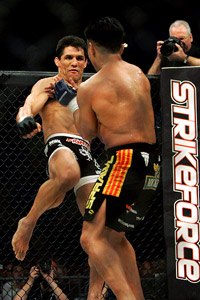that we have here in Cali.
but hopefully he still shows up clean because the lame CSAC somehow thinks Marijuana is a performance enhancer in the ring/cage.
Is chivalry dead? In Shamrock-Diaz, yes
var stobj = SHARETHIS.addEntry({
title:"Chiappetta:%20Manners%20don\'t%20matter%20for%20Diaz-Shamrock",
url:"http://sports.espn.go.com/extra/mma/news/story?id=3989523",
published: "2009-03-17"
});
stobj.attachButton(document.getElementById("espnstlink"));
By Mike Chiappetta
Special to ESPN.com
Archive
<!-- end mod-article-title --> <!-- begin story body --> <!-- isa photo -->
These days, most MMA event promotions are as chivalrous as Roger Federer and Rafael Nadal meeting at the net. There is, of course, nothing wrong with good old-fashioned sportsmanship, but every once in a while, it's nice to get a blast of MMA's raw roots.
And if you like "raw," look no further than Strikeforce's April 11 main event, featuring Frank Shamrock versus Nick Diaz.
Love him or hate him, Shamrock draws a reaction. Love him or hate him, Diaz does the same. Together, they are two magnetic forces destined to wage war using outrageous words and unpredictable actions.

At the recent news conference announcing the show, the fighters walked in from opposite sides of the stage. As both extended their hands, presumably to greet each other, Diaz instead raised his middle finger. Shamrock, always the master of self-generated buzz, could do nothing but smile.
"After seeing him there, I thought he was going to cry," said Shamrock, who is 23-9 with two draws. "He picks a most unintelligent way to express himself. I see MMA going down that path. I see martial arts as something beautiful and sacred. I think he sees it as a way to get chicks and hang out."
Diaz's action essentially served to put the loquacious Shamrock, 36, on the defensive. But his playing the role of MMA's guardian is a position Diaz's camp says is totally unnecessary.
"Frank likes to say and do certain things, to position himself mentally and get the advantage so you come into the fight at a disadvantage," said Cesar Gracie, who trains Diaz (18-7) and once lost to Shamrock in the cage. "Unfortunately for Frank, Nick's not affected by it. That's the statement he was making at the press conference. He doesn't want the games. It's combat, and we're doing it Nick's way."
Interestingly, the two men come from similar backgrounds. Shamrock once was a troubled youth who spent time in juvenile halls and foster homes before finding structure in martial arts. Diaz is a high school dropout who came from relative poverty to establish himself as one of the sport's most exciting fighters. The two train at gyms about an hour apart, in the San Francisco Bay area. At this stage, the only difference between them is the polish in their presentations.
Shamrock is dapper and eloquent, a spokesman of the sport who eventually will pull double duty as a ringside analyst for the Strikeforece/Showtime production. Diaz, meanwhile, favors sweatshirts and jeans, and often peppers his language with expletives.
Shamrock, who described Diaz as a "game and good fighter" but "a troubled young man" and a "bad representative of the sport," said he has known Diaz for about five years and that the two always have been cordial until now.
"Frank can talk all he wants, but I'm going to beat him up," Diaz said. "Let's see how much he fights back."
Gracie says Diaz is simply misunderstood.
"Nick is the nicest guy in the world and one of the most loyal friends you can have," Gracie said. "He's an unpretentious person and goes out of his way to help people. But he had to grow up and earn everything he has. He sees a guy fighting him as trying to take that away."
Diaz does little to help his public perception. He once got into a fight with Joe Riggs at a hospital after fighting Riggs in the cage; upon losing a 2007 title fight because of a cut stoppage, he flipped off the ringside doctor and shoved away a camera.
He also is well known for a positive marijuana test that overturned a victory over Takanori Gomi. Diaz, who lives in California and has a medical marijuana use card for attention deficit hyperactivity disorder, nevertheless must test clean to fight. And Diaz has never been afraid to fight.
He trains maniacally and participates in three or four full-length triathlons a year. He takes fights personally and enters the cage with a scowl. He strikes with strikers and grapples with ground experts. The destination of the fight isn't important, as long as there is a fight, so much so that even Gracie admits Diaz's willingness to brawl has been a detriment.
"But fans really appreciate his warrior spirit," Gracie said.
As an example of his quest for competition, in this bout, Diaz will move up from 160 pounds to fight Shamrock at a catch weight of 179 (Shamrock usually fights at 185). Gracie said Diaz could fight all the way up to 205.
"He brings it, and that makes him dangerous," Shamrock said. "But he doesn't know how to deal with the moment and with emotions. I always pick on my opponent, but with him it's almost unfair."
Strikeforce president Scott Coker said he originally thought the fight made sense because of the history of the Shamrocks and Gracies, as well as matching up the particular styles of Shamrock and Diaz. But he also knew how combustible the two fighters could be together.
The beauty of MMA is that you have to answer for your sins, and there is a lot more sinning to be done until the opening bell.